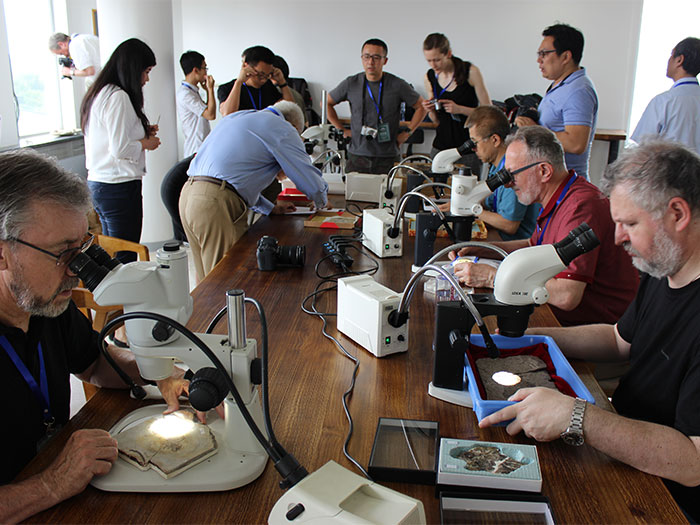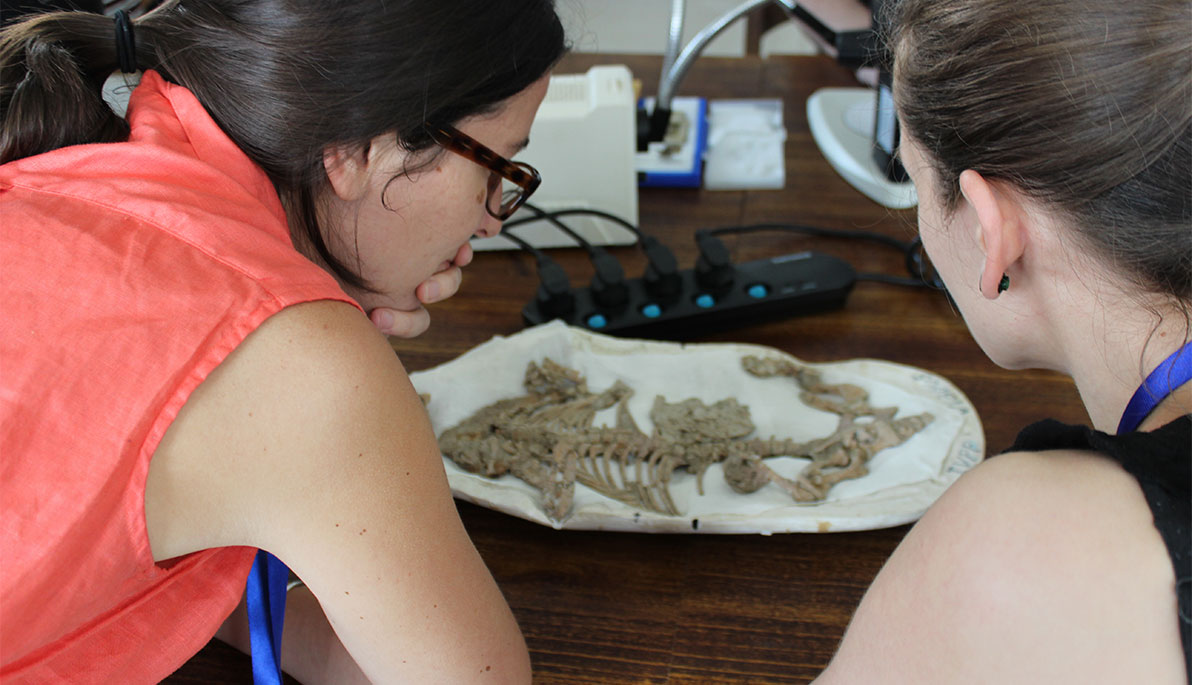News
Q&A: Simone Hoffmann on Early Mammal Fossil Discoveries in China
July 10, 2018
Pictured: Assistant Professor Simone Hoffmann, left, studying one of the fossils on display at the Beijing Natural History Museum.
A new exhibit at the Beijing Natural History Museum features a collection of more than 50 newly discovered fossils that shed new light on the evolution of early mammals.
“All of the fossils are from the Mesozoic, more specifically from Jurassic and Cretaceous localities,” explained NYIT College of Osteopathic Medicine Assistant Professor Simone Hoffmann, Ph.D. She was one of 10 international researchers who specialize in early mammal evolution to be invited to a private viewing of the fossils at the International Symposium on Mesozoic Mammal Evolution in June.
She sat down with The Box to talk about her trip and what this discovery means for future research.
Why did you decide it was important to travel to Beijing to see this exhibition?
This is the first time that many of these fossils are on exhibit and accessible to foreign and Chinese researchers. Many of the fossils are deposited in local museums across China that are often difficult and costly to reach. Having all these fossils in one place was a great opportunity to get together. This was also one of the reasons for me to join, not just because of the fantastic fossils, but also because so many other early mammal paleontologists from around the globe were there. It was a lot of fun to study and discuss these fossils with my colleagues.
What is the significance of these mammalian fossils?
Fossils from China have turned our views of early mammals upside down. Before the Chinese discoveries, we knew very little about mammals that lived during the time of dinosaurs (251-266 million years ago). Skeletons and skulls of early mammals were extremely rare; studying the origin of mammals was basically limited to isolated teeth and fragmentary jaws. While teeth can tell us about what these animals ate they leave many questions about the ecology and behavior of these mammals unanswered. Within the last 20 years an incredible number of complete skeletons have been discovered in China. About 50 fossils were showcased in Beijing and that is really only the tip of the iceberg. The number of well-preserved specimens is absolutely astonishing. It seems like a never-ending resource, almost every year there are new mammal fossils published that push our understanding of mammals forward.
What kinds of fossils were on display?
Many of them are what we call holotypes (this means the first specimen for that species). They cover very different groups of mammaliaforms (mammals and their closest fossil relatives). This includes docodonts, a very early branch of mammaliaforms that until recently were interpreted to be diggers and live close to the water like moles or desmans. But discoveries from China show that there were gliding forms as well. So even the very earliest mammaliaforms already occupied very different niches.
Then there are eutriconodonts, these include the largest Mesozoic mammals known to date (about the size of a medium- to large-sized dog). Many eutriconodonts were carnivorous and some of them were large enough to prey on dinosaurs. One of the fossils I saw has little dinosaur bones preserved in its stomach region.

International and Chinese researchers studying fossil mammals at the Institute of Vertebrate Paleontology and Paleoanthropology in Beijing.
The Chinese fossils also include one of the most successful and long-lived group of early mammals—the multituberculates. These were rodent-like fossils that are mainly known from the northern hemisphere.
And then there are some of the earliest therians (marsupials and placentals—the group that includes humans). These include Eomaia (the name means early dawn mother) and Juramaia (Jurassic mother), some of our very earliest mammalian ancestors.
What do we now know about these mammals that we didn't know before and what new things can be learned?
Through these discoveries we now know that early mammals were much more diverse than previously thought and that they already filled many of the niches that mammals occupy today. There were mammals that could swim and lived along rivers or lakes similar to beavers today, some that would dig and live underground similar to moles, some that lived in the trees and were able to glide, and some that were as large as a pitbull that even hunted small dinosaurs.
Among the Chinese discoveries is also a group called euharamiyidans (mammalioforms), which recently became a hot topic among mammal paleontologists. One of the biggest debates among early mammal researchers is whether euharamiyidans are placed within crown Mammalia (clade consisting of the last common ancestor of us and monotremes). This might sound trivial but it has large implications for the timing of mammal evolution. Among euharamiyidan relatives are some of the oldest fossils known for mammaliaforms. If placed within mammals, then this pushes the origin of mammals a good 40 million years back into the Triassic period. Much of our time at the conference was spent looking at these euharamiyidans and discussing their morphology.
How does the symposium and exhibit relate to your work?
I am currently working on several different projects related to early mammals. These findings and everything that is still to come has a huge influence on my research. It is impossible to work on early mammals and not consider these Chinese fossils.
Through the discoveries from China we have a much better understanding of early mammals from the northern hemisphere but we really know next to nothing about mammals from the southern hemisphere.
One of the most exciting projects for me is describing a complete skeleton of a new mammal from the Cretaceous period found in Madagascar, which I am working on with with colleagues at the Denver Museum of Nature and Science. This mammal is really bizarre and finding its next closest relative or group of relatives in the fossil tree of life is quite tricky. We are now in the process of figuring out how this animal moved and lived and what its closest relatives were. Seeing these early mammals from China was instrumental for our analyses.
This interview has been edited and condensed.


_Thumb.jpg)


